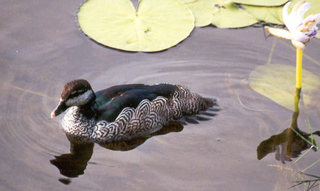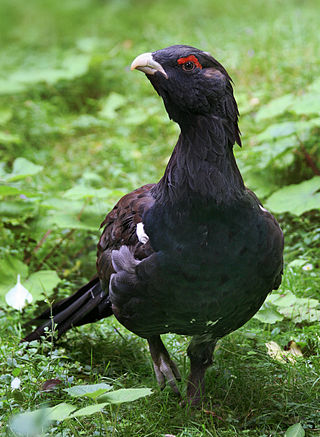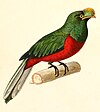
A harrier is a member of the genus Circus in the a bird of prey family Accipitridae. Harriers characteristically hunt by flying low over open ground, feeding on small mammals, reptiles, or birds. The young of the species are sometimes referred to as ring-tail harriers. They are distinctive with long wings, a long narrow tail, the slow and low flight over grasslands and skull peculiarities. The harriers are thought to have diversified with the expansion of grasslands and the emergence of C4 grasses about 6 to 8 million years ago during the Late Miocene and Pliocene.

Tropicbirds are a family, Phaethontidae, of tropical pelagic seabirds. They are the sole living representatives of the order Phaethontiformes. For many years they were considered part of the Pelecaniformes, but genetics indicates they are most closely related to the Eurypygiformes. There are three species in one genus, Phaethon. The scientific names are derived from Ancient Greek phaethon, "sun". They have predominantly white plumage with elongated tail feathers and small feeble legs and feet.

The four species of avocets are a genus, Recurvirostra, of waders in the same avian family as the stilts. The genus name comes from Latin recurvus, 'curved backwards' and rostrum, 'bill'. The common name is thought to derive from the Italian (Ferrarese) word avosetta. Francis Willughby in 1678 noted it as the "Avosetta of the Italians".

The nutcrackers (Nucifraga) are a genus of four species of passerine bird, in the family Corvidae, related to the jays and crows.

The three dowitchers are medium-sized long-billed wading birds in the genus Limnodromus. The English name "dowitcher" is from Iroquois, recorded in English by the 1830s.

Mergus is the genus of the typical mergansers fish-eating ducks in the subfamily Anatinae. The genus name is a Latin word used by Pliny the Elder and other Roman authors to refer to an unspecified waterbird.

The common reed bunting is a passerine bird in the bunting family Emberizidae, a group now separated by most modern authors from the finches, Fringillidae. The genus name Emberiza is from Old German Embritz, a bunting. The specific schoeniclus is from Ancient Greek skhoiniklos, a now unknown waterside bird.

Tragopan is a bird genus in the pheasant family Phasianidae. Member of the genus are commonly called "horned pheasants" because males have two brightly colored, fleshy horns on their head that can be erected during courtship displays. The habit of tragopans to nest in trees is unique among phasianids.

Pygmy geese are a group of very small "perching ducks" in the genus Nettapus which breed in the Old World tropics. They are the smallest of all wildfowl. As the "perching ducks" are a paraphyletic group, they need to be placed elsewhere. The initially assumed relationship with the dabbling duck subfamily Anatinae has been questioned, and it appears they form a lineage in an ancient Gondwanan radiation of waterfowl, within which they are of unclear affinities. An undescribed fossil species from the late Hemphillian of Jalisco, central Mexico, has also been identified from the distal end of a tarsometatarsus. It is only record of the genus in the New World.

The eiders are large seaducks in the genus Somateria. The three extant species all breed in the cooler latitudes of the Northern Hemisphere.

The anis are the three species of birds in the genus Crotophaga of the cuckoo family. They are essentially tropical New World birds, although the range of two species just reaches the United States.

Strix is a genus of owls in the typical owl family (Strigidae), one of the two generally accepted living families of owls, with the other being the barn-owl (Tytonidae). Common names are earless owls or wood owls, though they are not the only owls without ear tufts, and "wood owl" is also used as a more generic name for forest-dwelling owls. Neotropical birds in the genus Ciccaba are sometimes included in Strix.

Tetrao is a genus of birds in the grouse subfamily known as capercaillies. They are some of the largest living grouse. Feathers from the bird were used to create the characteristic hat of the bersaglieri, an Italian ace infantry formation.

Tachycineta is a genus of birds in the swallow family Hirundinidae. There are nine described species all restricted to the Americas.

Arborophila is a bird genus in the family Phasianidae. The genus has the second most members within the Galliformes after Pternistis, although Arborophila species vary very little in bodily proportions with different species varying only in colouration/patterning and overall size. These are fairly small, often brightly marked partridges found in forest of eastern and southern Asia. Some species in this genus have small ranges, and are threatened by habitat loss and hunting.

The white-eared jacamar is a species of bird in the family Galbulidae. It is found in Brazil, Colombia, Ecuador and Peru.

The Purus jacamar is a species of bird in the family Galbulidae. It is found in Bolivia, Brazil, and Peru.

Pytilia is a genus of small brightly coloured seed-eating birds in the family Estrildidae. They are distributed across Africa.

Tinamus is a genus of birds in the tinamou family Tinamidae. This genus comprises some of the larger members of this South American family.

Galbuli is one of the two suborders of the order Piciformes. It includes two families, Bucconidae (puffbirds) and Galbulidae (jacamars), both restricted to the Neotropics.
































